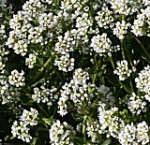 My paternal grandmother, Helen S Wright, included a recipe for wine made from scurvy grass in her book, Old Time Recipes for Home Made Wines . In times past scurvy-grass was consumed by sailors to cure scurvy, a common deficiency disease resulting from a lack of fresh vegetables in the diet. Scurvy grass is a low, creeping plant native to Europe where it grows in a variety of environments from salt marshes of coastal areas to alpine habitats. It belong to the cabbage family, Brassicaceae, that all includes broccoli, stock, and alyssum and has rounded spoon-shaped leaves and white flowers with four petals.
My paternal grandmother, Helen S Wright, included a recipe for wine made from scurvy grass in her book, Old Time Recipes for Home Made Wines . In times past scurvy-grass was consumed by sailors to cure scurvy, a common deficiency disease resulting from a lack of fresh vegetables in the diet. Scurvy grass is a low, creeping plant native to Europe where it grows in a variety of environments from salt marshes of coastal areas to alpine habitats. It belong to the cabbage family, Brassicaceae, that all includes broccoli, stock, and alyssum and has rounded spoon-shaped leaves and white flowers with four petals.
Gramdmother’s recipe ends with a note suggesting she was aware of the health benefits of scurvy grass wine but how much she knew is not revealed. She grew up in Washington D.C., the daughter of a navel architect, and could have been familiar with the problems faced by sailors when they returned home from a long voyage.
Here is the recipe in grandmother’s words.
Take the best large scurvy-grass tops and leaves, in May, June, or July; bruise them well in a stone mortar. Put them in a well-glazed earthen vessel and sprinkle them over with some powder of crystal of tartar; then smear them with some virgin honey, and being covered close let it stand twenty-four hours. Set water over a gentle fire, putting to every gallon three pints of honey, and when the scum rises, take it off and let it cool. Then put the stamped scurvy-grass into a barrel, and pour the liquor to it, setting the vessel conveniently edgeways, with a tap at the bottom. When it has been infused twenty-four hours, draw off the liquor, strongly press the juice and moisture out of the herb into the barrel or vessel, and put the liquor up again. Then put a little new yeast to it, and suffer it to ferment three days, covering the bung or vent with a piece of bread spread over with mustard-seed, downward, in a cool place, and let it continue till it is fine and drinks brisk. Drain off the finest part, leaving only the dregs behind; afterward add more herb and ferment it with whites of eggs, flour, and fixed nitre, very nice, or the juice of green grapes, if they are to be had, to which add six pounds of syrup of mustard, all mixed and well beaten together, to refine it down, and it will drink brisk, but it is not very pleasant, being here inserted among artificial wines rather for the sake of health than for the delightfulness of its taste.
To buy Old Time Recipes for Home Made Wines by Helen S. Wright Click Here.